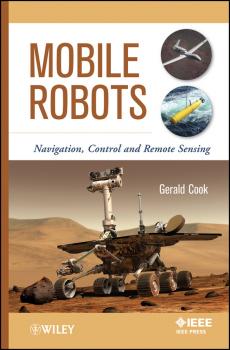ТОП просматриваемых книг сайта:
Gerald Cook
Список книг автора Gerald CookАннотация
Presents the normal kinematic and dynamic equations for robots, including mobile robots, with coordinate transformations and various control strategies This fully updated edition examines the use of mobile robots for sensing objects of interest, and focus primarily on control, navigation, and remote sensing. It also includes an entirely new section on modeling and control of autonomous underwater vehicles (AUVs), which exhibits unique complex three-dimensional dynamics. Mobile Robots: Navigation, Control and Sensing, Surface Robots and AUVs, Second Edition starts with a chapter on kinematic models for mobile robots. It then offers a detailed chapter on robot control, examining several different configurations of mobile robots. Following sections look at robot attitude and navigation. The application of Kalman Filtering is covered. Readers are also provided with a section on remote sensing and sensors. Other chapters discuss: target tracking, including multiple targets with multiple sensors; obstacle mapping and its application to robot navigation; operating a robotic manipulator; and remote sensing via UAVs. The last two sections deal with the dynamics modeling of AUVs and control of AUVs. In addition, this text: Includes two new chapters dealing with control of underwater vehicles Covers control schemes including linearization and use of linear control design methods, Lyapunov stability theory, and more Addresses the problem of ground registration of detected objects of interest given their pixel coordinates in the sensor frame Analyzes geo-registration errors as a function of sensor precision and sensor pointing uncertainty Mobile Robots: Navigation, Control and Sensing, Surface Robots and AUVs is intended for use as a textbook for a graduate course of the same title and can also serve as a reference book for practicing engineers working in related areas.
Аннотация
An important feature of this book is the particular combination of topics included. These are (1) control, (2) navigation and (3) remote sensing, all with application to mobile robots. Much of the material is readily extended to any type ground vehicle. In the controls area, robot steering is the issue. Both linear and nonlinear models are treated. Various control schemes are utilized, and through these applications the reader is introduced to methods such as: (1) Linearization and use of linear control design methods for control about a reference trajectory, (2) Use of Lyapunov stability theory for nonlinear control design, (3) Derivation of optimal control strategies via Pontryagin’s maximum principle, (4) Derivation of a local coordinate system which is fundamental for the steering of vehicles along a path never before traversed. This local coordinate system has application regardless of the control design methods utilized. In the navigation area, various coordinate systems are introduced, and the transformations among them are derived. (1) The Global Positioning System (GPS) is introduced and described in significant detail. (2) Also introduced and discussed are inertial navigation systems (INS). These two methods are treated in terms of their ability to provide vehicle position as well as attitude. A preceding chapter is devoted to coordinate rotations and transformations since they play an important role in the understanding of this body of theory.
Аннотация
An important feature of this book is the particular combination of topics included. These are (1) control, (2) navigation and (3) remote sensing, all with application to mobile robots. Much of the material is readily extended to any type ground vehicle. In the controls area, robot steering is the issue. Both linear and nonlinear models are treated. Various control schemes are utilized, and through these applications the reader is introduced to methods such as: (1) Linearization and use of linear control design methods for control about a reference trajectory, (2) Use of Lyapunov stability theory for nonlinear control design, (3) Derivation of optimal control strategies via Pontryagin’s maximum principle, (4) Derivation of a local coordinate system which is fundamental for the steering of vehicles along a path never before traversed. This local coordinate system has application regardless of the control design methods utilized. In the navigation area, various coordinate systems are introduced, and the transformations among them are derived. (1) The Global Positioning System (GPS) is introduced and described in significant detail. (2) Also introduced and discussed are inertial navigation systems (INS). These two methods are treated in terms of their ability to provide vehicle position as well as attitude. A preceding chapter is devoted to coordinate rotations and transformations since they play an important role in the understanding of this body of theory.



